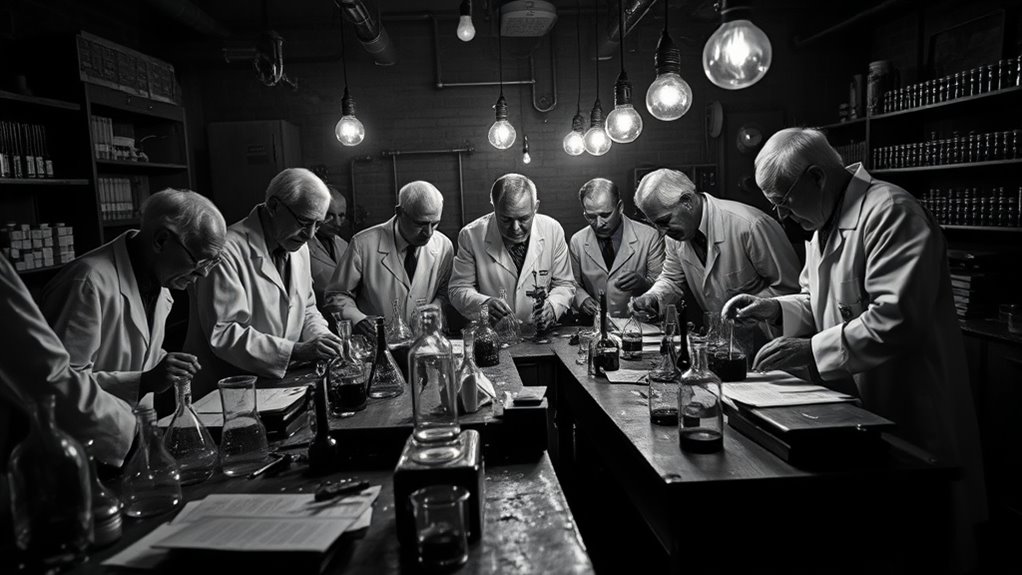While physicists often get the spotlight, chemists in the Manhattan Project made crucial contributions behind the scenes. They developed methods for uranium enrichment and produced plutonium, transforming complex reactions into practical processes. Their expertise in radioactive materials and isotope separation was essential for weapon success. Through innovation and teamwork, these chemists turned scientific theory into real-world technology. To discover more about their important roles and discoveries, explore the story of these often-overlooked pioneers.
Key Takeaways
- Chemists developed isotope separation techniques like gaseous diffusion and electromagnetic separation critical for producing weapons-grade uranium.
- They isolated and purified fissile isotopes such as uranium-235 and plutonium-239, enabling effective nuclear reactions.
- Chemical processes for large-scale plutonium extraction from reactor materials were pioneered by Manhattan Project chemists.
- Chemists created methods to safely handle, store, and analyze radioactive materials, ensuring project safety and efficiency.
- Their collaborative innovations transformed nuclear chemistry into a practical science essential for the success of the atomic bomb.

Have you ever wondered who truly drove the scientific breakthroughs behind the Manhattan Project? While many focus on the famous physicists like Oppenheimer and Fermi, it’s essential to recognize the critical contributions of chemists whose work in nuclear chemistry laid the groundwork for the project’s success. These chemists navigated complex reactions, isotopic separations, and material synthesis, often working behind the scenes but with impact just as profound as their more celebrated counterparts. Their expertise and dedication were indispensable in transforming theoretical principles into practical applications capable of producing the first atomic weapons.
Nuclear chemistry was at the heart of the Manhattan Project’s scientific effort. These chemists specialized in understanding radioactive materials, isolating specific isotopes, and developing methods to produce fissile material efficiently. For instance, they played a pivotal role in refining uranium and creating the processes needed for uranium enrichment. Their work in isotope separation—employing techniques like gaseous diffusion and electromagnetic separation—was essential for obtaining weapons-grade uranium. Without these breakthroughs in nuclear chemistry, the project’s goal of producing enough fissile material within a limited timeframe would have been impossible.
Their meticulous experiments, often conducted under intense secrecy, required a high level of scientific collaboration across laboratories and institutions, bringing together chemists, physicists, and engineers. This collaborative effort was fundamental in overcoming the technical challenges that each discipline faced, fostering innovative solutions that pushed the project forward.
You mightn’t realize it, but the chemists’ contributions extended beyond just understanding nuclear reactions. They developed methods for handling highly radioactive materials safely, designed chemical processes to separate plutonium from other elements, and optimized these procedures for large-scale production. Their work demanded precision, patience, and a deep understanding of chemical principles, as well as the ability to adapt and improve existing techniques under extreme pressure.
The collaborative environment of the Manhattan Project enabled chemists to exchange ideas rapidly, troubleshoot problems collectively, and refine their methods in real time. This spirit of scientific collaboration accelerated discoveries that, in turn, advanced nuclear chemistry and the broader field of radiochemistry.
In essence, these forgotten chemists were instrumental in transforming nuclear chemistry from a theoretical pursuit into a practical science capable of achieving one of the most significant and controversial technological feats of the 20th century. Their contributions were often overshadowed by physicists, but without their meticulous work and collaborative spirit, the Manhattan Project’s success would have been uncertain.
Recognizing their role highlights the interdisciplinary nature of scientific breakthroughs and reminds us how essential unseen teamwork is in achieving monumental goals.
Frequently Asked Questions
How Did These Chemists’ Backgrounds Influence Their Contributions?
Your question about how their backgrounds influenced their contributions highlights the significance of educational backgrounds and cultural influences. These chemists’s diverse experiences shaped their approaches to problem-solving and innovation.
Their varied education and cultural perspectives fueled creative insights and collaboration. You can see how their unique backgrounds helped them tackle complex scientific challenges, ultimately advancing the project’s goals and making essential discoveries that might’ve been overlooked otherwise.
Were Any of These Chemists Recognized During or After the Project?
Recognition struggles often cast shadows over unsung heroes, and these chemists are no exception. During the project, many received little acknowledgment for their crucial contributions, and post-project acknowledgment remained scarce.
You might wonder if their efforts gained recognition at last. Sadly, most remained in obscurity, their groundbreaking work overshadowed by broader achievements, revealing how easily genius can be lost in the shadows of history’s spotlight.
What Specific Challenges Did They Face in Their Research?
You face significant challenges in research, especially with material shortages that limit your experiments and progress. Ethical dilemmas also weigh heavily, forcing you to contemplate the moral implications of your work.
These obstacles demand creative solutions and resilience, often making your breakthroughs harder to achieve. Managing these issues requires careful balancing of scientific curiosity with responsibility, ensuring your work advances while respecting ethical boundaries.
How Did Their Discoveries Impact Later Nuclear Chemistry?
You might think their discoveries only impacted wartime efforts, but they truly revolutionized nuclear chemistry. By uncovering new nuclear reaction pathways, these chemists paved the way for advanced radioactive isotope applications in medicine, industry, and research.
Their work made nuclear technology safer and more precise, influencing everything from cancer treatments to energy production. You now see how foundational their breakthroughs are in shaping modern scientific and practical uses of nuclear science.
Are There Surviving Records of Their Personal Experiences During the Project?
You can find some surviving records of their personal experiences through personal diaries and oral histories. These documents offer firsthand insights into their thoughts and challenges during the project.
While not exhaustive, they help you understand their perspectives and contributions. Exploring archives and interviews can give you a deeper connection to their stories, revealing the human side behind the groundbreaking scientific achievements of the Manhattan Project.
Conclusion
So, next time you marvel at nuclear science, don’t forget the chemists who mostly disappeared into the shadows—probably because they knew too much. Their groundbreaking discoveries kept the project ticking but didn’t land them a Nobel or a fancy biography. Instead, they’re left in history’s cellar, quietly fueling modern technology while you enjoy your peaceful, bomb-free dinner. Cheers to the unsung heroes—whose brilliance, apparently, was better off forgotten.








